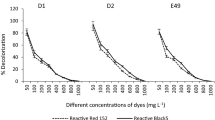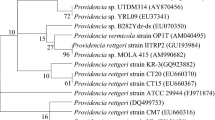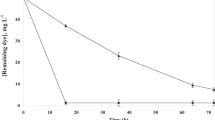Abstract
Shewanella xiamenensis BC01 (SXM) was isolated from sediment collected off Xiamen, China and was identified based on the phylogenetic tree of 16S rRNA sequences and the gyrB gene. This strain showed high activity in the decolorization of textile azo dyes, especially methyl orange, reactive red 198, and recalcitrant dye Congo red, decolorizing at rates of 96.2, 93.0, and 87.5 %, respectively. SXM had the best performance for the specific decolorization rate (SDR) of azo dyes compared to Proteus hauseri ZMd44 and Aeromonas hydrophila NIU01 strains and had an SDR similar to Shewanella oneidensis MR-1 in Congo red decolorization. Luria-Bertani medium was the optimal culture medium for SXM, as it reached a density of 4.69 g-DCW L−1 at 16 h. A mediator (manganese) significantly enhanced the biodegradation and flocculation of Congo red. Further analysis with UV–VIS, Fourier Transform Infrared spectroscopy, and Gas chromatography–mass spectrometry demonstrated that Congo red was cleaved at the azo bond, producing 4,4′-diamino-1,1′-biphenyl and 1,2′-diamino naphthalene 4-sulfonic acid. Finally, SEM results revealed that nanowires exist between the bacteria, indicating that SXM degradation of the azo dyes was coupled with electron transfer through the nanowires. The purpose of this work is to explore the utilization of a novel, dissimilatory manganese-reducing bacterium in the treatment of wastewater containing azo dyes.







Similar content being viewed by others
References
Arora S, Saini HS, Singh K (2011) Biological decolorization of industrial dyes by Candida tropicalis and Bacillus firmus. Water Sci Technol 63:761–768
Cai PJ, Xiao X, He YR, Li WW, Chu J, Wu C, He MX, Zhang Z, Sheng GP, Lam MH, Xu F, Yu HQ (2011) Anaerobic biodecolorization mechanism of methyl orange by Shewanella oneidensis MR-1. Appl Microbiol Biotechnol 93:1769–1776
Chen CH, Chang CF, Ho CH, Tsai TL, Liu SM (2008) Biodegradation of crystal violet by a Shewanella sp. NTOU1. Chemosphere 72:1712–1720
Chen BY, Zhang MM, Chang CT, Ding Y, Lin KL, Chiou CS, Hsueh CC, Xu H (2010a) Assessment upon azo dye decolorization and bioelectricity generation by Proteus hauseri. Bioresour Technol 101:4737–4741
Chen CH, Chang CF, Liu SM (2010b) Partial degradation mechanisms of malachite green and methyl violet B by Shewanella decolorationis NTOU1 under anaerobic conditions. J Hazard Mater 177:281–289
Clarke TA, Edwards MJ, Gates AJ, Hall A, White GF, Bradley J, Reardon CL, Shi L, Beliaev AS, Marshall MJ, Wang Z, Watmough NJ, Fredrickson JK, Zachara JM, Butt JN, Richardson DJ (2011) Structure of a bacterial cell surface decaheme electron conduit. Proc Natl Acad Sci USA 108:9384–9389
Donnini S, Prinsi B, Negri AS, Vigani G, Espen L, Zocchi G (2010) Proteomic characterization of iron deficiency responses in Cucumis sativus L. roots. BMC Plant Biol 10:268–283
Doshi H, Ray A, Kothari IL, Gami B (2006) Spectroscopic and scanning electron microscopy studies of bioaccumulation of pollutants by algae. Curr Microbiol 53:148–157
El-Naggar MY, Wanger G, Leung KM, Yuzvinsky TD, Southam G, Yang J, Lau WM, Nealson KH, Gorby YA (2010) Electrical transport along bacterial nanowires from Shewanella oneidensis MR-1. Proc Natl Acad Sci U S A 107:18127–18131
Fredrickson JK, Romine MF, Beliaev AS, Auchtung JM, Driscoll ME, Gardner TS, Nealson KH, Osterman AL, Pinchuk G, Reed JL, Rodionov DA, Rodrigues JL, Saffarini DA, Serres MH, Spormann AM, Zhulin IB, Tiedje JM (2008) Towards environmental systems biology of Shewanella. Nat Rev Microbiol 6:592–603
Georgiou D, Aivasidis A (2006) Decoloration of textile wastewater by means of a fluidized-bed loop reactor and immobilized anaerobic bacteria. J Hazard Mater 135:372–377
Gopinath KP, Murugesan S, Abraham J, Muthukumar K (2009) Bacillus sp. mutant for improved biodegradation of Congo red: random mutagenesis approach. Bioresour Technol 100:6295–6300
Han JL, Ng IS, Wang Y, Zheng X, Chen WM, Hsueh CC, Liu SQ, Chen BY (2012) Exploring new strains of dye-decolorizing bacteria. J Biosci Bioeng 113:508–514
Hsueh CC, Chen BY (2007) Comparative study on reaction selectivity of azo dye decolorization by Pseudomonas luteola. J Hazard Mater 141:842–849
Hsueh CC, Chen BY, Yen CY (2009) Understanding effects of chemical structure on azo dye decolorization characteristics by Aeromonas hydrophila. J Hazard Mater 167:995–1001
Huang J, Sun B, Zhang X (2010) Shewanella xiamenensis sp. nov., isolated from coastal sea sediment. Int J Syst Evol Microbiol 60:1585–1589
Khalid A, Arshad M, Crowley DE (2008) Decolorization of azo dyes by Shewanella sp. under saline conditions. Appl Microbiol Biotechnol 79:1053–1059
Kotloski NJ, Gralnick JA (2013) Flavin electron shuttles dominate extracellular electron transfer by Shewanella oneidensis. MBio 4 (1) doi:10.1128/mBio.00553-12
Kuhad RC, Sood N, Tripathi KK, Singh A, Ward OP (2004) Developments in microbial methods for the treatment of dye effluents. Adv Appl Microbiol 56:185–213
Marsili E, Baron DB, Shikhare ID, Coursolle D, Gralnick JA, Bond DR (2008) Shewanella secretes flavins that mediate extracellular electron transfer. Proc Natl Acad Sci USA 105:3968–3973
Mitter EK, Corso CR (2012) Acid Black 48 dye biosorption using Saccharomyces cerevisiae immobilized with treated sugarcane bagasse. Water Sci Technol 66:1431–1438
Mu Y, Rabaey K, Rozendal RA, Yuan ZG, Keller J (2009) Decolorization of azo dyes in bioelectrochemical systems. Environ Sci Technol 43:5137–5143
Mugerfeld I, Law BA, Wickham GS, Thompson DK (2009) A putative azoreductase gene is involved in the Shewanella oneidensis response to heavy metal stress. Appl Microbiol Biotechnol 82:1131–1141
Novotny C, Rawal B, Bhatt M, Patel M, Sasek V, Molitoris HP (2001) Capacity of Irpex lacteus and Pleurotus ostreatus for decolorization of chemically different dyes. J Biotechnol 89:113–122
Ozer A, Akkaya G, Turabik M (2006) Biosorption of Acid Blue 290 (AB 290) and Acid Blue 324 (AB 324) dyes on Spirogyra rhizopus. J Hazard Mater 135:355–364
Pazdzior K, Klepacz–Smolka A, Ledakowicz S, Sojka-Ledakowicz J, Mrozinska Z, Zylla R (2009) Integration of nanofiltration and biological degradation of textile wastewater containing azo dye. Chemosphere 75:250–255
Pearce CI, Christie R, Boothman C, von Canstein H, Guthrie JT, Lloyd JR (2006) Reactive azo dye reduction by Shewanella strain J18 143. Biotechnol Bioeng 95:692–703
Telke AA, Kalyani DC, Dawkar VV, Govindwar SP (2009) Influence of organic and inorganic compounds on oxidoreductive decolorization of sulfonated azo dye C.I. Reactive Orange 16. J Hazard Mater 172:298–309
Telke AA, Joshi SM, Jadhav SU, Tamboli DP, Govindwar SP (2010) Decolorization and detoxification of Congo red and textile industry effluent by an isolated bacterium Pseudomonas sp. SU-EBT. Biodegradation 21:283–296
Van der Zee FP, Cervantes FJ (2009) Impact and application of electron shuttles on the redox (bio) transformation of contaminants: a review. Biotechnol Adv 27:256–277
Watanabe K, Manefield M, Lee M, Kouzuma A (2009) Electron shuttles in biotechnology. Curr Opin Biotech 20:633–641
Xu M, Guo J, Zeng G, Zhong X, Sun G (2006) Decolorization of anthraquinone dye by Shewanella decolorationis S12. Appl Microbiol Biotechnol 71:246–251
Xu M, Guo J, Sun G (2007) Biodegradation of textile azo dye by Shewanella decolorationis S12 under microaerophilic conditions. Appl Microbiol Biotechnol 76:719–726
Yang YY, Du LN, Wang G, Jia XM, Zhao YH (2011) The decolorisation capacity and mechanism of Shewanella oneidensis MR-1 for methyl orange and acid yellow 199 under microaerophilic conditions. Water Sci Technol 63:956–963
Zhang MM, Chen WM, Chen BY, Chang CT, Hsueh CC, Ding Y, Lin KL, Xu H (2010) Comparative study on characteristics of azo dye decolorization by indigenous decolorizers. Bioresour Technol 101:2651–2656
Acknowledgment
The authors are grateful to the financial support by the Chinese National Natural Science Foundation (21206141) and the Fujian Provincial Department of Science and Technology (2012I0009). The authors also sincerely appreciate the academic connection program between Xiamen University (China) and National I-Lan University (Taiwan) in 2011–2013 for the study.
Author information
Authors and Affiliations
Corresponding author
Additional information
Tingting Chen and Rong Lin are in equal contribution.
Rights and permissions
About this article
Cite this article
Ng, IS., Chen, T., Lin, R. et al. Decolorization of textile azo dye and Congo red by an isolated strain of the dissimilatory manganese-reducing bacterium Shewanella xiamenensis BC01. Appl Microbiol Biotechnol 98, 2297–2308 (2014). https://doi.org/10.1007/s00253-013-5151-z
Received:
Revised:
Accepted:
Published:
Issue Date:
DOI: https://doi.org/10.1007/s00253-013-5151-z




